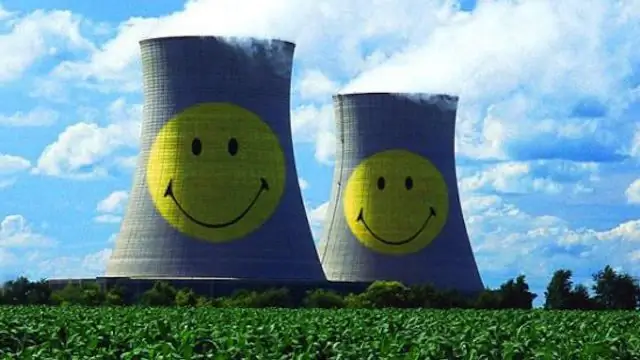2026 Author: Howard Calhoun | [email protected]. Last modified: 2025-01-24 13:10:39
Gas turbine units (GTP) are a single, relatively compact power complex, in which a power turbine and a generator work in pairs. The system has become widespread in the so-called small-scale power industry. Great for power and heat supply of large enterprises, remote settlements and other consumers. As a rule, gas turbines operate on liquid fuel or gas.

On the edge of progress
In increasing the energy capacity of power plants, the leading role is transferred to gas turbine units and their further evolution - combined cycle plants (CCGT). Thus, at US power plants since the early 1990s, more than 60% of the commissioned and modernized capacities are already gas turbines and combined cycle plants, and in some countries in some years their share reached 90%.
Simple gas turbines are also built in large numbers. The gas turbine plant - mobile, economical to operate and easy to repair - proved to be the optimal solution to cover peak loads. At the turn of the century (1999-2000), the total capacitygas turbine units reached 120,000 MW. For comparison: in the 1980s, the total capacity of systems of this type was 8,000-10,000 MW. A significant part of the gas turbines (more than 60%) were intended to operate as part of large binary combined cycle plants with an average power of about 350 MW.

Historical background
Theoretical foundations for the use of combined cycle technologies were studied in sufficient detail in our country in the early 60s. Already at that time, it became clear that the general path for the development of thermal power engineering is connected precisely with combined cycle technologies. However, their successful implementation required reliable and highly efficient gas turbine units.
It was the significant progress in gas turbine construction that determined the modern qualitative leap in thermal power engineering. A number of foreign firms successfully solved the problem of creating efficient stationary gas turbines at a time when domestic leading leading organizations in a command economy were promoting the least promising steam turbine technologies (STP).
If in the 60s the efficiency of gas turbine installations was at the level of 24-32%, then in the late 80s the best stationary power gas turbine installations already had an efficiency (with autonomous use) of 36-37%. This made it possible to create CCGTs on their basis, the efficiency of which reached 50%. By the beginning of the new century, this figure was equal to 40%, and in combination with combined cycle gas-cycle plants, it was even 60%.

Comparison of steam turbineand combined cycle plants
In combined-cycle plants based on gas turbines, the immediate and real prospect was to obtain an efficiency of 65% or more. At the same time, for steam turbine plants (developed in the USSR), only if a number of complex scientific problems related to the generation and use of steam of supercritical parameters are successfully solved, one can hope for an efficiency of no more than 46-49%. Thus, in terms of efficiency, steam turbine systems are hopelessly inferior to combined cycle systems.
Significantly inferior to steam turbine power plants also in terms of cost and construction time. In 2005, in the world energy market, the price of 1 kW for a CCGT unit with a capacity of 200 MW or more was $500-600/kW. For CCGTs of smaller capacities, the cost was in the range of $600-900/kW. Powerful gas turbine plants correspond to values of 200-250 $/kW. With a decrease in unit power, their price increases, but usually does not exceed $ 500 / kW. These values are several times less than the cost of a kilowatt of electricity in steam turbine systems. For example, the price of an installed kilowatt at condensing steam turbine power plants ranges from $2000-3000/kW.

Scheme of a gas turbine plant
The installation includes three basic units: a gas turbine, a combustion chamber and an air compressor. Moreover, all units are housed in a prefabricated single building. The compressor and turbine rotors are rigidly connected to each other, supported by bearings.
Combustion chambers (for example, 14 pieces) are placed around the compressor, each in its own separate housing. For admission toThe air compressor serves as an inlet pipe, air leaves the gas turbine through the exhaust pipe. The gas turbine body is based on powerful supports placed symmetrically on a single frame.
Working principle
Most gas turbine units use the principle of continuous combustion, or open cycle:
- First, the working fluid (air) is pumped at atmospheric pressure by the appropriate compressor.
- Further, the air is compressed to a higher pressure and sent to the combustion chamber.
- It is supplied with fuel, which burns at a constant pressure, providing a constant supply of heat. Due to the combustion of fuel, the temperature of the working fluid increases.
- Next, the working fluid (now it is already a gas, which is a mixture of air and combustion products) enters the gas turbine, where, expanding to atmospheric pressure, it does useful work (turns the turbine that generates electricity).
- After the turbine, the gases are discharged into the atmosphere, through which the working cycle closes.
- The difference between the operation of the turbine and the compressor is perceived by an electric generator located on a common shaft with the turbine and compressor.

Intermittent combustion plants
Unlike the previous design, intermittent combustion uses two valves instead of one.
- The compressor forces air into the combustion chamber through the first valve while the second valve is closed.
- When the pressure in the combustion chamber rises, the first valve is closed. As a result, the volume of the chamber is closed.
- When the valves are closed, fuel is burned in the chamber, naturally, its combustion occurs at a constant volume. As a result, the pressure of the working fluid further increases.
- Next, the second valve is opened, and the working fluid enters the gas turbine. In this case, the pressure in front of the turbine will gradually decrease. When it approaches atmospheric, the second valve should be closed, and the first one should be opened and repeat the sequence of actions.

Gas turbine cycles
Turning to the practical implementation of one or another thermodynamic cycle, designers have to face many insurmountable technical obstacles. The most characteristic example: when the steam humidity is more than 8-12%, the losses in the flow path of the steam turbine increase sharply, dynamic loads increase, and erosion occurs. This ultimately leads to the destruction of the flow path of the turbine.
As a result of these restrictions in the energy sector (for getting a job), only two basic thermodynamic cycles are widely used so far: the Rankine cycle and the Brayton cycle. Most power plants are based on a combination of elements of these cycles.
The Rankine cycle is used for working fluids that make a phase transition during the implementation of the cycle; steam power plants operate according to this cycle. For working fluids that cannot be condensed under real conditions and which we call gases, the Brayton cycle is used. Through this cyclegas turbine plants and internal combustion engines are operating.
Fuel used
The vast majority of gas turbines are designed to run on natural gas. Sometimes liquid fuels are used in low-power systems (less often - medium, very rarely - high power). A new trend is the transition of compact gas turbine systems to the use of solid combustible materials (coal, less often peat and wood). These trends are due to the fact that gas is a valuable technological raw material for the chemical industry, where its use is often more profitable than in the energy sector. The production of gas turbine plants capable of operating efficiently on solid fuel is actively gaining momentum.

Difference between ICE and GTU
The fundamental difference between internal combustion engines and gas turbine complexes is as follows. In an internal combustion engine, the processes of air compression, fuel combustion and expansion of combustion products occur within one structural element, called the engine cylinder. In gas turbines, these processes are separated into separate structural units:
- compression is carried out in the compressor;
- combustion of fuel, respectively, in a special chamber;
- expansion of combustion products is carried out in a gas turbine.
As a result, gas turbines and internal combustion engines have little structural similarity, although they operate according to similar thermodynamic cycles.
Conclusion
With the development of small-scale power generation, increasing its efficiency, GTP and STP systems occupy an increasing share in the totalenergy system of the world. Accordingly, the promising profession of a gas turbine operator is increasingly in demand. Following Western partners, a number of Russian manufacturers have mastered the production of cost-effective gas turbine units. Severo-Zapadnaya CHPP in St. Petersburg became the first combined-cycle power plant of a new generation in Russia.
Recommended:
Fuel-free energy. Prospects for alternative energy in Russia

Modern energy is based mainly on hydrocarbon fuel, which is used in various forms and types in almost all sectors of the national economy around the world. In Russia, fuel materials are not just a source of energy, but also an export commodity on which the economic model of development depends. In many ways, this explains the tasks of the country's leadership, focusing on the development of alternative energy sources in order to reduce dependence on the traditional resource
Reviews about TC "Energy". Transport company "Energy": addresses, cargo delivery

If you are faced with the need to transport some things or goods, then there is always a problem with finding a car and a driver. Entrust it to professionals, contact TC "Energy"
Work permit for work in electrical installations. Rules for work in electrical installations. Work permit

From August 2014, Law No. 328n comes into force. In accordance with it, a new edition of the "Rules on labor protection during the operation of electrical installations" is being introduced
Nuclear power plants. Nuclear power plants of Ukraine. Nuclear power plants in Russia

Modern energy needs of mankind are growing at a gigantic pace. Its consumption for lighting cities, for industrial and other needs of the national economy is increasing. Accordingly, more and more soot from burning coal and fuel oil is emitted into the atmosphere, and the greenhouse effect increases. In addition, there has been more and more talk in recent years about the introduction of electric vehicles, which will also contribute to the increase in electricity consumption
Gas turbine power plants. Mobile gas turbine power plant

For the functioning of industrial and economic facilities located at a considerable distance from the centralized power lines, small-scale power generating installations are used. They can operate on various types of fuel. Gas turbine power plants are most widely used due to their high efficiency, ability to generate thermal energy and a number of other features

